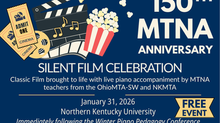Cultivating Creative, Motived Students - Part 1: Using Multimedia
- Jan 21, 2016
- 3 min read
Despite music being a creative endeavor, teachers often get stuck in a monotonous routine of doing the same things the same way all the time. Even if we have good ideas, methods, and approaches, using the same ones over and over can lead to complacency and mental exhaustion, not just for you, but also for your students! Here are 3 things you can do to engage your students and bring out the creative musician: Use multimedia Improvise Get up and move! In this first of 3 parts, we will be discussing the use of multimedia.Don’t let this word scare you. It doesn’t necessarily mean you have to be the most tech-savvy teacher in the world. I simply mean involving other forms of art besides music, mostly visual. This includes photos, videos, graphics, etc. Here are some ways to use multimedia: 1. Use photos and videos to stimulate the imagination. This can work in both group classes and private lessons. - Show students a few examples and ask which one they think best fits the music - Ask students what image or scene might go with their piece - Look online together for possibilities of images and videos - Play a group game where you (the teacher) play a short example and students guess which picture it is. You might have several pictures already printed out or on your computer screen like this:

- You can also have students improvise (more on this topic in part 2), having other students guess which image they are playing 2. Use a graphics visualizer that responds to sound. A visualizer is a program or app that shows fluid graphics with different colors and shapes which respond to the sound. Let students experiment to see how they can get the visual to react. This is especially great for students who have trouble with dynamic contrast. When they can SEE the effect their sound is having right there on the computer screen, they HAVE to adjust in order to get the desired visual result. This is also great for giving a lot of time during rests and fermatas. The visual effects look mesmerizing when the sound fades off or stops, and then starts again. Here are some examples of this visualizer in use at one of our annual multimedia concerts, "Music Alive!":
My favorite visualizer is G-force by Sound Spectrum. Click the link below for more information and a free trial. But you'll have to purchase the $30 Platinum version if you want it to react to live sounds. http://www.soundspectrum.com/g-force/index.html?src=home 3. Add multimedia to performances. Granted, a little more planning and effort has to go into this, but it’s well worth it! Students can pair their performances with a photo slideshow, video, or graphics visualizer. The benefits are numerous, but here are just a few: - unlocks the imagination and creativity - takes some pressure off, having the audience watch the projection screen instead of all eyes being on the student - audience enjoyment is heightened - students also enjoy seeing the other students more, instead of sitting in their seat, being bored waiting their turn Here's an example of one of my students' videos during a performance. She's playing Anne Crosby's "To Fly Like an Eagle", and chose the video clips to match her performance:
As you can imagine, going through the process of choosing images and videos to go with music is a very enriching experience for students. I hope you will explore the fun, creative, and engaging world of multimedia music! For further information on this topic, refer to the 2-part article that I co-wrote: “Using Multimedia to Enhance Lessons and Recitals,” in American Music Teacher (June/July and August/September of 2015). Stay tuned for parts 2 and 3!





























Comments